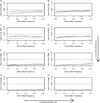Approximate and exact tests of Hardy-Weinberg equilibrium using uncertain genotypes
- PMID: 21922537
- PMCID: PMC4141651
- DOI: 10.1002/gepi.20612
Approximate and exact tests of Hardy-Weinberg equilibrium using uncertain genotypes
Abstract
Testing for Hardy-Weinberg equilibrium (HWE) is commonly used as a quality control filter in genome-wide scans for markers with experimentally determined genotypes. In contrast, for markers with imputed genotypes, there are post-imputation metrics of quality that can be used as screens but there are no formal tests of deviation from HWE. Similarly, there are no formal tests of deviation from HWE for probabilistic genotypes that are generated by sequencing projects. Here, I describe generalizations of the approximate χ(2) and exact tests of HWE for use with uncertain genotypes. The tests fully account for the probabilities of all possible genotypes at a marker for each individual. By computer simulation, the approximate and exact tests are shown to maintain valid control of the type I error rate. Calculations of the loss of power as the uncertainty in genotypes increases are illustrated. The tests are compatible with chip-based genotypes for single-nucleotide polymorphisms and copy number polymorphisms, imputed genotypes, and probabilistic assignments of genotype from variable-coverage sequence data.
© 2011 Wiley Periodicals, Inc.
Figures

Similar articles
-
A POWERFUL METHOD FOR INCLUDING GENOTYPE UNCERTAINTY IN TESTS OF HARDY-WEINBERG EQUILIBRIUM.Pac Symp Biocomput. 2017;22:368-379. doi: 10.1142/9789813207813_0035. Pac Symp Biocomput. 2017. PMID: 27896990 Free PMC article.
-
Exact tests of Hardy-Weinberg equilibrium and homogeneity of disequilibrium across strata.Am J Hum Genet. 2006 Dec;79(6):1071-80. doi: 10.1086/510257. Epub 2006 Nov 3. Am J Hum Genet. 2006. PMID: 17186465 Free PMC article.
-
Detection of genotyping errors and pseudo-SNPs via deviations from Hardy-Weinberg equilibrium.Genet Epidemiol. 2005 Nov;29(3):204-14. doi: 10.1002/gepi.20086. Genet Epidemiol. 2005. PMID: 16080207 Free PMC article.
-
[Application of chi-square test and exact test in Hardy-Weinberg equilibrium testing].Fa Yi Xue Za Zhi. 2004;20(2):116-9. Fa Yi Xue Za Zhi. 2004. PMID: 15311526 Review. Chinese.
-
Genotype Imputation from Large Reference Panels.Annu Rev Genomics Hum Genet. 2018 Aug 31;19:73-96. doi: 10.1146/annurev-genom-083117-021602. Epub 2018 May 23. Annu Rev Genomics Hum Genet. 2018. PMID: 29799802 Review.
Cited by
-
Prospective cohort study of the risk factors for stress fractures in Chinese male infantry recruits.J Int Med Res. 2016 Aug;44(4):787-95. doi: 10.1177/0300060516639751. Epub 2016 May 20. J Int Med Res. 2016. PMID: 27207942 Free PMC article.
-
Efficient test for deviation from Hardy-Weinberg equilibrium with known or ambiguous typing in highly polymorphic loci.Brief Bioinform. 2024 Jul 25;25(5):bbae416. doi: 10.1093/bib/bbae416. Brief Bioinform. 2024. PMID: 39302340 Free PMC article.
-
A POWERFUL METHOD FOR INCLUDING GENOTYPE UNCERTAINTY IN TESTS OF HARDY-WEINBERG EQUILIBRIUM.Pac Symp Biocomput. 2017;22:368-379. doi: 10.1142/9789813207813_0035. Pac Symp Biocomput. 2017. PMID: 27896990 Free PMC article.
-
Calculating Polygenic Risk Scores (PRS) in UK Biobank: A Practical Guide for Epidemiologists.Front Genet. 2022 Feb 18;13:818574. doi: 10.3389/fgene.2022.818574. eCollection 2022. Front Genet. 2022. PMID: 35251129 Free PMC article.
-
Impact of Hardy-Weinberg disequilibrium on post-imputation quality control.Hum Genet. 2013 Sep;132(9):1073-5. doi: 10.1007/s00439-013-1336-x. Epub 2013 Jul 11. Hum Genet. 2013. PMID: 23842951 No abstract available.
References
-
- Bentley DR, Balasubramanian S, Swerdlow HP, Smith GP, Milton J, Brown CG, Hall KP, Evers DJ, Barnes CL, Bignell HR, Boutell JM, Bryant J, Carter RJ, Cheetham RK, Cox AJ, Ellis DJ, Flatbush MR, Gormley NA, Humphray SJ, Irving LJ, Karbelashvili MS, Kirk SM, Li H, Liu X, Maisinger KS, Murray LJ, Obradovic B, Ost T, Parkinson ML, Pratt MR, Rasolonjatovo IMJ, Reed MT, Rigatti R, Rodighiero C, Ross MT, Sabot A, Sankar SV, Scally A, Schroth GP, Smith ME, Smith VP, Spiridou A, Torrance PE, Tzonev SS, Vermaas EH, Walter K, Wu X, Zhang L, Alam MD, Anastasi C, Aniebo IC, Bailey DMD, Bancarz IR, Banerjee S, Barbour SG, Baybayan PA, Benoit VA, Benson KF, Bevis C, Black PJ, Boodhun A, Brennan JS, Bridgham JA, Brown RC, Brown AA, Buermann DH, Bundu AA, Burrows JC, Carter NP, Castillo N, Catenazzi MCE, Chang S, Cooley RN, Crake NR, Dada OO, Diakoumakos KD, Dominguez-Fernandez B, Earnshaw DJ, Egbujor UC, Elmore DW, Etchin SS, Ewan MR, Fedurco M, Fraser LJ, Fuentes Fajardo KV, Furey WS, George D, Gietzen KJ, Goddard CP, Golda GS, Granieri PA, Green DE, Gustafson DL, Hansen NF, Harnish K, Haudenschild CD, Heyer NI, Hims MM, Ho JT, Horgan AM, Hoschler K, Hurwitz S, Ivanov DV, Johnson MQ, James T, Jones TAH, Kang G-D, Kerelska TH, Kersey AD, Khrebtukova I, Kindwall AP, Kingsbury Z, Kokko-Gonzales PI, Kumar A, Laurent MA, Lawley CT, Lee SE, Lee X, Liao AK, Loch JA, Lok M, Luo S, Mammen RM, Martin JW, McCauley PG, McNitt P, Mehta P, Moon KW, Mullens JW, Newington T, Ning Z, Ng BL, Novo SM, O’Neill MJ, Osborne MA, Osnowski A, Ostadan O, Paraschos LL, Pickering L, Pike AC, Pike AC, Pinkard DC, Pliskin DP, Podhasky J, Quijano VJ, Raczy C, Rae VH, Rawlings SR, Rodriguez AC, Roe PM, Rogers J, Rogert Bacigalupo MC, Romanov N, Romieu A, Roth RK, Rourke NJ, Ruediger ST, Rusman E, Sanches-Kuiper RM, Schenker MR, Seoane JM, Shaw RJ, Shiver MK, Short SW, Sizto NL, Sluis JP, Smith MA, Sohna Sohna JE, Spence EJ, Stevens K, Sutton N, Szajkowski L, Tregidgo CL, Turcatti G, vandeVondele S, Verhovsky Y, Virk SM, Wakelin S, Walcott GC, Wang J, Worsley GJ, Yan J, Yau L, Zuerlein M, Rogers J, Mullikin JC, Hurles ME, McCooke NJ, West JS, Oaks FL, Lundberg PL, Klenerman D, Durbin R, Smith AJ. Accurate whole human genome sequencing using reversible terminator chemistry. Nature. 2008;456:53–59. - PMC - PubMed
-
- Chapco W. An exact test of the Hardy-Weinberg law. Biometrics. 1976;32:183–189. - PubMed
-
- Cox DG, Kraft P. Quantification of the power of Hardy-Weinberg equilibrium testing to detect genotyping error. Hum Hered. 2006;61:10–14. - PubMed
-
- Elston RC, Forthofer R. Testing for Hardy-Weinberg equilibrium in small samples. Biometrics. 1977;33:536–542.
Publication types
MeSH terms
Grants and funding
LinkOut - more resources
Full Text Sources

